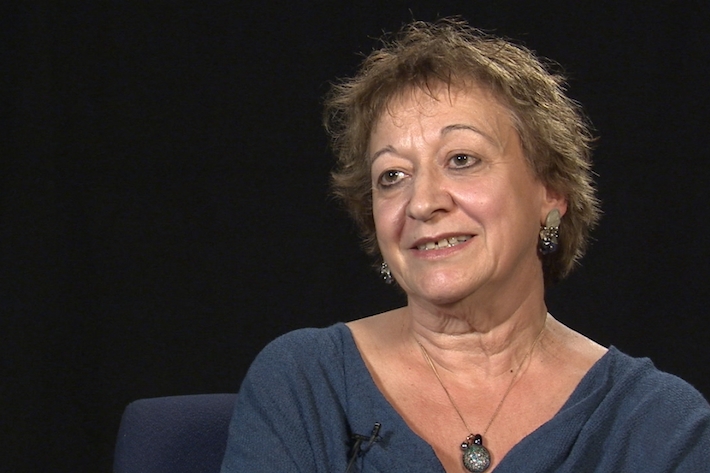Gamma-ray bursts are the most powerful, brightest explosions in the universe, and for more than two decades they have captured the imagination of Chryssa Kouveliotou, a high-energy astrophysicist at NASA’s Marshall Space Flight Center in Huntsville, Ala.
The explosions are transient events that occur about once a day when massive stars collapse into black holes or when two neutron stars collide, outshining the rest of the cosmos for milliseconds up to a few minutes. Astrophysicists like Dr. Kouveliotou study gamma-ray bursts to learn more about the formation and expansion of our universe.
Dr. Kouveliotou has dedicated much of her career to investigating these fiery flares of energy, even before they were on the scientific community’s radar. While at NASA, Dr. Kouveliotou was part of the original team to prove that gamma rays come from outside the galaxy. She is recognized for her discovery of two different classes of gamma-ray bursts.
Dr. Kouveliotou’s work also proved that soft-gamma repeaters—slowly rotating neutron stars that also emit bursts of light—are actually so-called “magnetars” that possess the most extreme magnetic fields in nature. Unlike gamma-ray bursts, these astrophysical objects are recurrent, rather than one-time events.
In February, Dr. Kouveliotou will leave her post at NASA to join the Department of Physics at George Washington University’s Columbian College of Arts and Sciences.
A native of Athens, Greece, Dr. Kouveliotou has received numerous awards for her achievements, including the Descartes Prize, the Dannie Heineman Prize in astrophysics and the NASA Exceptional Service Medal. In 2012, she was named one of Time Magazine's 25 most influential people in space. She is also a member of the National Academy of Sciences, one of the highest professional honors among scientists, engineers and doctors.
Located just 18 miles from Goddard Space Flight Center and a short distance from numerous other research institutions, GW is in a position to help the astrophysicist forge new discoveries, Dr. Kouveliotou said.
“It combines the academic environment and also the research environment because GW is located in a hub of educational institutions and research centers,” Dr. Kouveliotou said. “I believe that, being an academic, I will have more opportunities and resources to innovate and form new collaborations.”
This supercomputer simulation shows one of the most violent events in the universe: a pair of neutron stars colliding, merging and forming a black hole. Scientists think neutron star mergers like this produce short gamma-ray bursts.
GW has a long history of attracting influential physicists to its classrooms. President Cloyd Heck Marvin recruited George Gamow—best known as the father of the “big bang” theory—to the Columbian College in 1934. During his 22-year career at GW, the world-renowned physicist and cosmologist developed the theory, which asserts that the universe formed in a giant explosion billions of years ago.
Physics Department Chair Bill Briscoe believes that Dr. Kouveliotou’s presence at GW will once again propel astrophysics to the forefront. But her research has implications far beyond the university’s borders.
“Everything we are comes from the stars,” Dr. Briscoe said. “You can not understand what our world is made of unless you understand how stars are born and how they die.”
Stars first hypnotized Dr. Kouveliotou as a young girl in Athens, where she would spend summer nights gazing at the brightly dotted skies. After studying physics at the University of Athens, she earned a master’s degree in astronomy in England and a Ph.D. in astrophysics at the Technical University of Munich. After working on and off at Goddard Space Flight Center while teaching in Athens, Dr. Kouveliotou accepted a research position at Marshall in the early '90s and joined NASA as a senior scientist in 2004.
She describes her job as “detective work,” as she seeks to piece together the grand puzzle of how the universe operates.
“How do we make stars, galaxies and of course, planets?” Dr. Kouveliotou said. “I have always liked solving mysteries.”
Until recently, gamma-ray bursts were the “biggest mystery in high-energy astronomy,” according to NASA. U.S. military satellites discovered the explosions while on the lookout for Soviet nuclear testing in 1967, but for years knowledge about their origins remained scarce since very few instruments capable of observing gamma-ray bursts existed.
Dr. Kouveliotou became interested in the brand new phenomenon as a Ph.D. student in 1978. She joined a team of scientists at Marshall in 1991 that had designed and built an impressive instrument—called the Burst and Transient Source Experiment (BATSE)—to fly on the Compton Gamma-ray Observatory, which was dedicated to burst detection.
With this instrument, Dr. Kouveliotou and her colleagues could, for the first time, gather data on the curious bursts that had puzzled her for years. Since that watershed moment, Dr. Kouveliotou spends much of her time gathering and interpreting data from machines on board spacecrafts—which serve as her “eyes in the sky.”
“This is a little bit different than looking with your own eyes through a telescope, which is what I grew up hoping I would do. But, in a way, it’s more exciting,” Dr. Kouveliotou said. “It has huge discovery potential because we’re just at the beginning stages.”
Joining Dr. Kouveliotou at GW will be an assistant professor, a postdoctoral researcher and a graduate student. The scientist said she is looking forward to continuing her research with this team and collaborating with other faculty members at the university.
And she will continue, as always, to shoot for the stars.
“I intend to be involved as much as I can. This is what I’m shooting for,” Dr. Kouveliotou said. “The people who I’m coming with and the people that exist at and near the university are such fantastic scientists and personalities. I think all of this brain power can produce a tremendous amount of results.”


